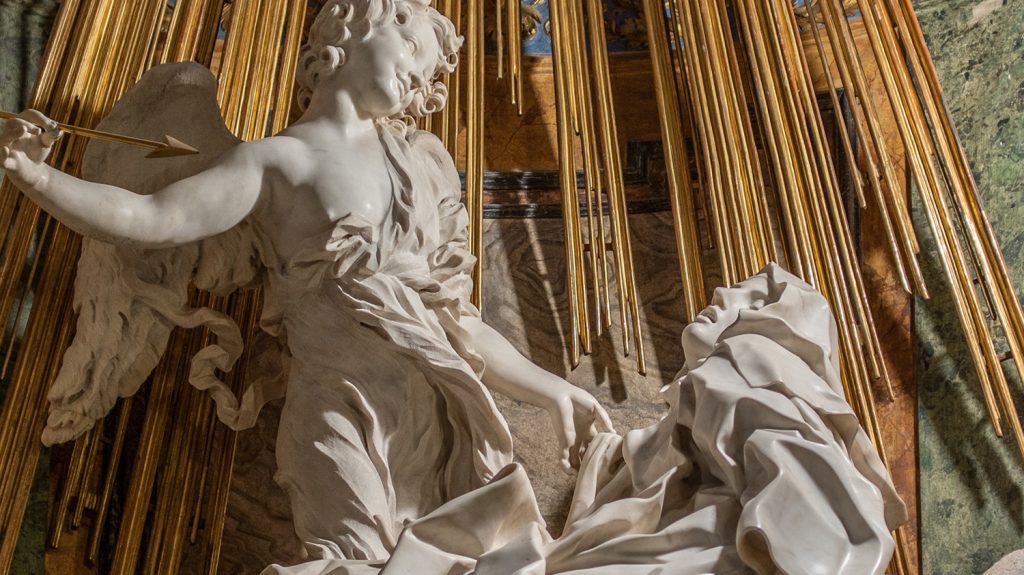It is the feast of St Teresa of Ávila (above), founder of the discalced (‘without shoes’, although they actually wore sandals) Carmelite order of nuns, as well as being a mystic and mystical theologian, who died today in 1582. Teresa unusually combined a practical and down to earth approach to herself and the organisation of her work, with a depth of spiritual experience that has made her one of the most widely read Spanish writers. Her own estimation of her experiences was shot through with humour. She once said she was ashamed to go to her confessor ‘for fear he might laugh at me and say, What a Saint Paul she is, with her visions!’ Teresa was declared to be a saint 40 years after she died.
O thou undaunted daughter of desires!
By all thy dower of lights and fires;
By all the eagle in thee, all the dove;
By all thy lives and deaths of love…
By all the Heav’n thou hast in Him
(Fair sister of the seraphim!);
By all of Him we have in thee;
Leave nothing of myself in me.
Richard Crashaw, ‘Upon the Book and Picture of the Seraphical Saint Teresa’
Today in 1991, physicists were surprised to discover a previously unknown high energy particle travelling at 99.999% of the speed of light over the US state of Utah. They theorised that it had been ejected from a supermassive black hole in a neighbouring galaxy. Their surprise was so great that they jokingly named it the Oh-My-God particle, a name which has stuck.
This day in 1582 was the first day of the Gregorian calendar for most of the Catholic countries of Europe, instituted by Pope Gregory XIII. For the previous 1,627 years, Western civilisation had followed Julius Caesar’s calendar, in which a year was reckoned to be exactly 365.25 days long. By 1582, the calendar was running 10 days slow against the reality of the solar year, which is 365.242 days long. The Church was horrified to learn it had been celebrating Easter (not to mention all the other days of the Church year) on the wrong day. So today became 24 October, and under the new calendar, 10 minutes and 48 seconds were snipped off the length of the year. The names of the months, and number of days in each of them, remained unchanged, so the modern year still follows important features from the ancient Julian calendar.
Today in 1764, Edward Gibbon had the first spark of inspiration that led to him writing one of the great books of his time, The History of the Decline and Fall of the Roman Empire. He was on a grand tour of Europe, and was in Rome. Published in six volumes between 1776 and 88, the book changed the course of his life, and many other lives too, as its negative critique of Christianity was highly influential throughout the 19th and into the 20th centuries.
‘It was at Rome, on the fifteenth of October 1764, as I sat musing inside the ruins of the Capitol, while the barefooted friars were singing vespers in the temple of Jupiter, that the idea of writing the decline and fall of the City first started to my mind.’ Edward Gibbon, Memoirs of My Life
Pope Leo XIII issued the Bull Dall’alto Dell’apostolico Seggio (‘From the height of the Apostolic Throne’) today in 1890, attacking freemasonry in Italy.
William Temple, Archbishop of Canterbury in the middle years of the Second World War, was born today in 1881 in Exeter, Devon. His father Frederick was also Archbishop of Canterbury (from 1896 to 1902), making them the only father and son to occupy the Chair of St Augustine.
Wasatch Beers, famous for poking fun at Utah, the home of Mormonism, opened a pub on Main Street in Salt Lake City today in 1986 and started brewing beer. Wasatch is best known for its Polygamy Porter, bearing the slogan, ‘Why have just one?’, but also brews Evolution Amber Ale: ‘Created in 27 days, not 7’.
Image: Steven Zucker
